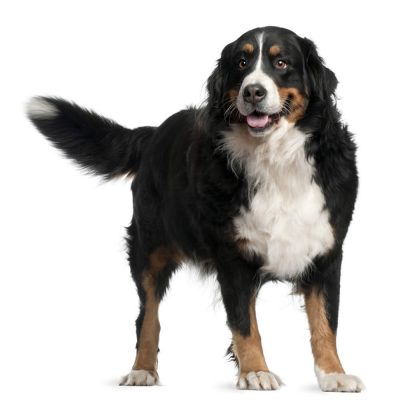Bernese Mountain Dog
Group 6: Utility
Height:
Male: 64 – 70 cm
Female: 58 – 66 cm
Energy Level: Moderate
Original Function: Working, herding
Lifespan: 8 – 10 yrs
Recommended for: Active people & families.

Group 6: Utility
Height:
Male: 64 – 70 cm
Female: 58 – 66 cm
Energy Level: Moderate
Original Function: Working, herding
Lifespan: 8 – 10 yrs
Recommended for: Active people & families.

The Bernese Mountain Dog can be traced back 2000 years, originally known as the Sennehund. They were used for herding cattle and guarding farms. The Swiss also used them as draught dogs, pulling small carts.
During the 1800’s the breed had very nearly disappeared due to the interest in the St Bernard, and the lack of concentrated breeding programs.
It was not until the turn of this century that a Swiss cynologist, Franz Schertenlieb, combed the countryside to find the last of these dogs. He did have some success around the Durrbach district of Berne and then Zurich professor, Albert Heim joined with him. Thanks to them, the Bernese Mountain Dog made a comeback.
They are a very handsome dog, lovely cheerful natures and gentle. They are very loyal to their families and love children. If they are not socialized with other people can very much become a one-person/family dog. It is advisable to socialize them, if for some reason they have to be re-homed; they will be able to adjust.
Appearance: Large, strong, working dog, active, alert, well boned, of striking colour. Almond shaped dark eyes, triangular highset ears hang to the side of the head. Long bushy tail, may be raised when running.
Temperament: Self-confident, good-natured, friendly and fearless, aggression should be discouraged.
Characteristics: A multi purpose farm dog capable of draught work. A kind and devoted family dog. Slow to mature.
Color: Jet black, with rich reddish brown on cheeks, over eyes, on all four legs and on chest. Slight to medium sized symmetrical white head marking (blaze) and white chest marking (cross) are essential.
Preferred but not essential – white paws, white not reaching higher than pastern, white tip to tail. A few white hairs at nape of neck, and white anal patch undesirable but tolerated.
Coat: Soft, silky with bright natural sheen, long, slightly wavy but should not curl when mature.
Grooming: Daily grooming is a must to keep them tangle-free and to reduce the amount of shedding. The hair between the pads should be trimmed regularly.
Exercise: For the first 12 months Bernese should be exercised as little as possible as their bones are growing and developing, but they do need to be taken out to socialized, after this regular walks are good, they tend to be on the lazy side.
Health: This breed is generally healthy but some can be prone to hip and elbow dysplasia, also hereditary eye disease and cancer.